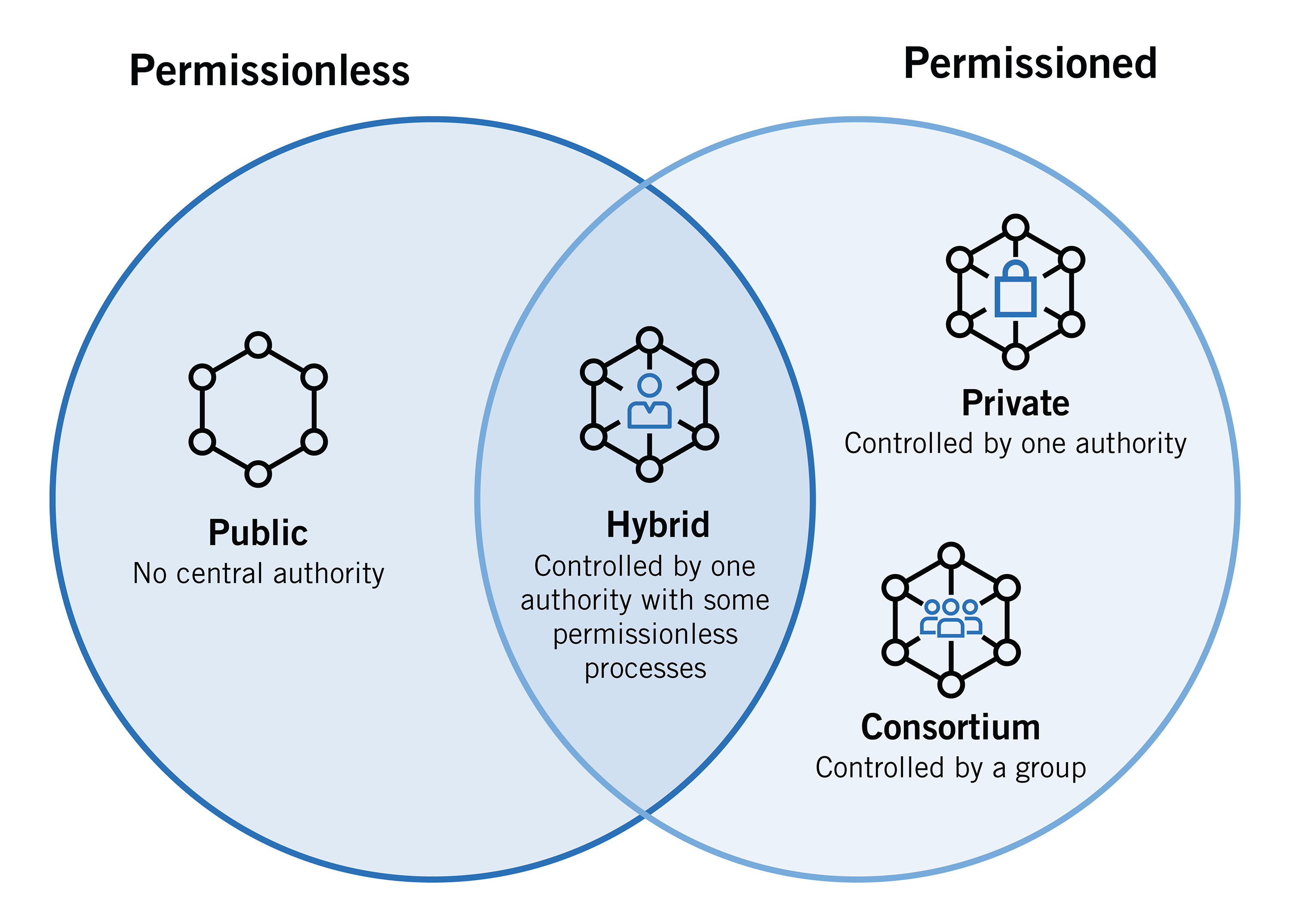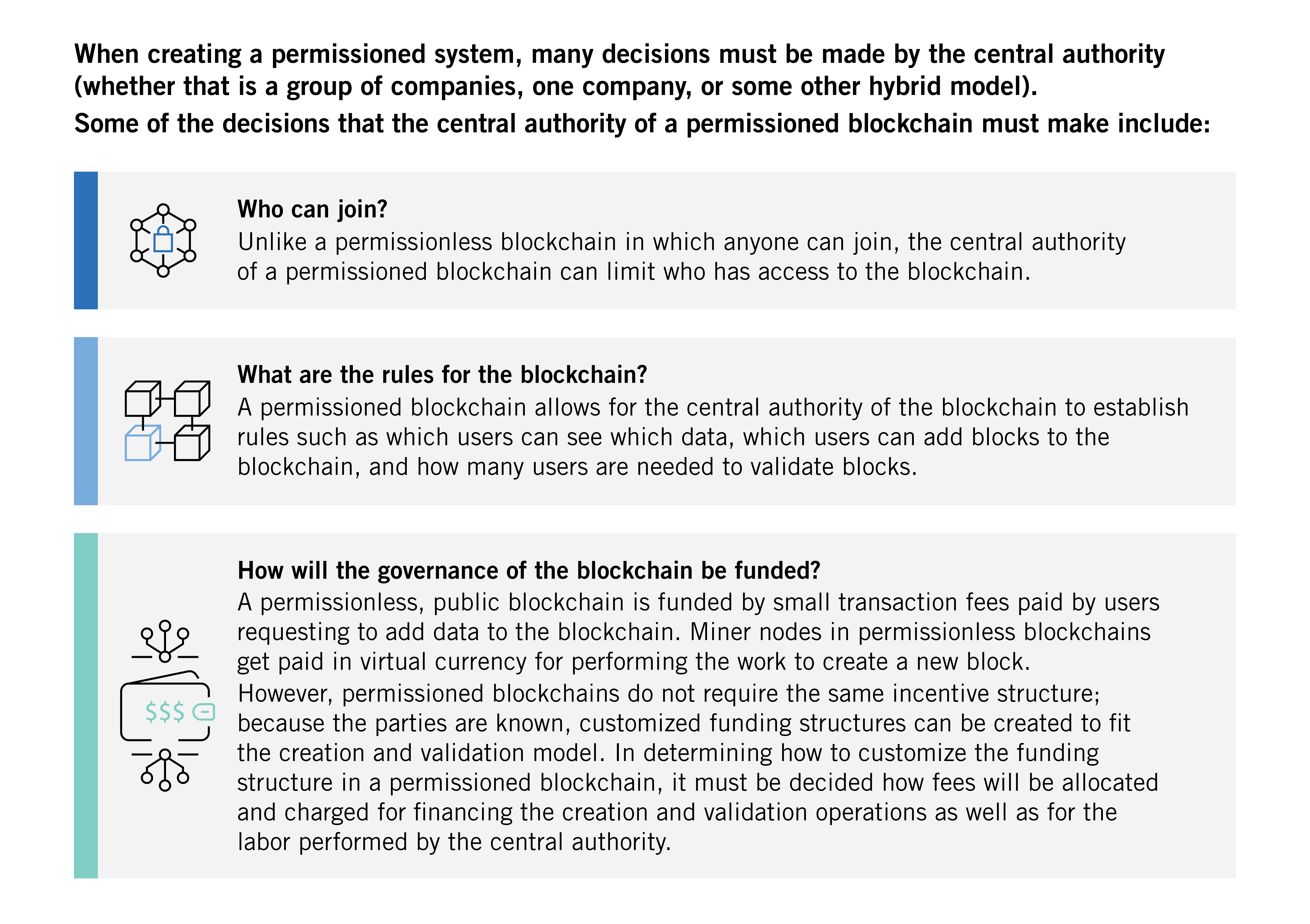Types of Blockchain: Public, Private, or Something in Between

When a company is formulating a blockchain solution to fill its supply chain needs, inevitably the decision must be made as to what type of blockchain is best suited for the project. Therefore, it is essential to have a clear understanding of the options available for blockchain structures. Not all types of blockchains are appropriate for supply chain information management.
Permissionless vs. Permissioned Blockchains
All types of blockchains can be characterized as permissionless, permissioned, or both. Permissionless blockchains allow any user to pseudo-anonymously join the blockchain network (that is, to become “nodes” of the network) and do not restrict the rights of the nodes on the blockchain network.
Conversely, permissioned blockchains restrict access to the network to certain nodes and may also restrict the rights of those nodes on that network. The identities of the users of a permissioned blockchain are known to the other users of that permissioned blockchain.
 Permissionless blockchains tend to be more secure than permissioned blockchains, because there are many nodes to validate transactions, and it would be difficult for bad actors to collude on the network. However, permissionless blockchains also tend to have long transaction processing times due to the large number of nodes and the large size of the transactions.
Permissionless blockchains tend to be more secure than permissioned blockchains, because there are many nodes to validate transactions, and it would be difficult for bad actors to collude on the network. However, permissionless blockchains also tend to have long transaction processing times due to the large number of nodes and the large size of the transactions.
On the other hand, permissioned blockchains tend to be more efficient. Because access to the network is restricted, there are fewer nodes on the blockchain, resulting in less processing time per transaction.
Like so many things, pros come with cons, and the reduced processing time in permissioned blockchains is no exception: the centralization of permissioned blockchains to some central authority (be it a government, a company, a trade group, or some other entity or group that is granting the permission to nodes and creating the restrictions of the blockchain) makes it a less secure system that is more prone to traditional hacking vulnerabilities. The fewer nodes there are on a blockchain, the easier it is for bad actors to collude, so private blockchain administrators must ensure nodes adding and verifying blocks are highly trusted.

Types of Blockchains
There are four types of blockchain structures:
1. Public Blockchains
Public blockchains are permissionless in nature, allow anyone to join, and are completely decentralized. Public blockchains allow all nodes of the blockchain to have equal rights to access the blockchain, create new blocks of data, and validate blocks of data.
To date, public blockchains are primarily used for exchanging and mining cryptocurrency. You may have heard of popular public blockchains such as Bitcoin, Ethereum, and Litecoin. On these public blockchains, the nodes “mine” for cryptocurrency by creating blocks for the transactions requested on the network by solving cryptographic equations. In return for this hard work, the miner nodes earn a small amount of cryptocurrency. The miners essentially act as new era bank tellers that formulate a transaction and receive (or “mine”) a fee for their efforts.
2. Private (or Managed) Blockchains
Private blockchains, which may also be referred to as managed blockchains, are permissioned blockchains controlled by a single organization. In a private blockchain, the central authority determines who can be a node. The central authority also does not necessarily grant each node with equal rights to perform functions. Private blockchains are only partially decentralized because public access to these blockchains is restricted. Some examples of private blockchains are the business-to-business virtual currency exchange network Ripple and Hyperledger, an umbrella project of open-source blockchain applications.
Both private and public blockchains have drawbacks – public blockchains tend to have longer validation times for new data than private blockchains, and private blockchains are more vulnerable to fraud and bad actors. To address these drawbacks, consortium and hybrid blockchains were developed.
3. Consortium Blockchains
Consortium blockchains are permissioned blockchains governed by a group of organizations, rather than one entity, as in the case of the private blockchain. Consortium blockchains, therefore, enjoy more decentralization than private blockchains, resulting in higher levels of security. However, setting up consortiums can be a fraught process as it requires cooperation between a number of organizations, which presents logistical challenges as well as potential antitrust risk (which we will examine in an upcoming article). Further, some members of supply chains may not have the needed technology nor the infrastructure to implement blockchain tools, and those that do may decide the upfront costs are too steep a price to pay to digitize their data and connect to other members of the supply chain.
A popular set of consortium blockchain solutions for the financial services industry and beyond has been developed by the enterprise software firm R3. In the supply chain sector, CargoSmart has developed the Global Shipping Business Network Consortium, a not-for-profit blockchain consortium which aims to digitalize the shipping industry and allow maritime industry operators to work more collaboratively.1
4. Hybrid blockchains
Hybrid blockchains are blockchains that are controlled by a single organization, but with a level of oversight performed by the public blockchain, which is required to perform certain transaction validations. An example of a hybrid blockchain is IBM Food Trust, which was developed to improve efficiency throughout the whole food supply chain. We will discuss IBM Food Trust in more detail in an upcoming article in this series.
Blockchain Types for Supply Chain Use
Because members of supply chains have important data privacy and competition considerations, blockchain for supply chain requires some extent of permissioned functionality, which exists in private, consortium and hybrid models of blockchain. It is therefore not surprising that Businesswire recently reported that consortium and hybrid blockchain types are expected to grow at the highest rate in the supply chain market from 2020-2026.2 Future articles in this “Blockchain in Supply Chain” series will explore some of the popular consortium and hybrid blockchains being implemented in the supply chain sector.
Decisions, Decisions

1 CargoSmart and Maritime Industry Operators Commit to Transforming the Shipping industry, CargoSmart (July 12, 2019), https://www.cargosmart.com/en/news/cargosmart-and-maritime-industry-operators-commit-to-transforming-the-shipping-industry.htm</a>; Our Platform, GSBN, https://www.gsbn.trade/our-platform (last retrieved July 19, 2021).
2 The Worldwide Blockchain Supply Chain Industry is Expected to Reach $3+ Billion by 2026 – ResearchAndMarkets.com. Businesswire (March 16, 2021), https://www.businesswire.com/news/home/20210316005759/en/The-Worldwide-Blockchain-Supply-Chain-Industry-is-Expected-to-Reach-3-Billion-by-2026—ResearchAndMarkets.com.

